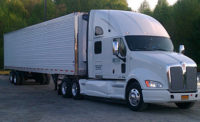Operating a cold storage warehouse is challenging due to the need to constantly maintain a certain temperature for storage purposes, while keeping the equipment and personnel warm and able to function at optimum capacity.
Refrigerated and frozen foods account for the majority of products stored in cold storage warehouses. In fact, the international frozen foods market alone is expected to grow from an estimated $165.4 billion in 2009 to $199.5 billion by 2016. Cold storage is also vital for other industries as well such as pharmaceuticals, petro-chemicals and even high-tech electronics.
Here are some challenges impacting cold storage warehouse management:
- Food protection
Regulating and maintaining the right temperature and humidity to maintain and extend the life of your products can be challenging as well as risky, as different products require different temperatures to be sustained. Traditional temperature monitoring systems depend solely on the experience of the operator who must be on-site to adjust and manage the whole system.
- Maintaining product’s lifecycle
Correctly maintaining the temperature of perishable products is necessary to preserve its quality and safety from the point of manufacture through the supply chain to the consumer. Failing to maintain proper shipment leads to textual degradation, discoloring, bruising and microbial growth of food products.
- Labeling product and racks
Barcode labels create the essential link between physical products and the computer systems that monitor receiving, storage, retrieval and shipments. Appropriate freeze-grade rack labels serve as a critical factor in the entire traceability system. Freezer-grade rack labels develop a strong permanent bond on common rack surfaces, and can be applied in environments as low as -20°F.
- Product traceability
In the case of temperature excursions, finding out and determining the affected product is only possible with accurate location information. Certain products like fresh produce require additional control over factors such as carbon dioxide and humidity. Very precise and accurate documentation is essential.
- Fulfillment and courier shipments
The entire cold chain process should be about minimizing the time it takes to move a product through the system. Efficiency is crucial, and vulnerabilities occur if there are delays in handing products off from one facility to another.
- The average shipment—both inbound from supplier to distribution center, and outbound to customers—is made up of less-than-truckload amounts of food products.
- All products must be loaded correctly to prevent any cross-contamination with the raw product and damage with the heavier items placed at the bottom.
Certain perishable foods, particularly seafood, pre-cut produce and ready-to-eat products, can become unsafe if not kept at the appropriate temperatures.
Here are some best practices in cold storage warehouse management:
- Form a contingency plan.
Even with the best monitoring technology, an unplanned delay or re-routing could jeopardize your shipment’s stability. Shippers must work with their transportation partners to develop contingency plans that clearly map out a strategy in the event of a delay.
- Guard against vulnerabilities.
To manage cold chain shipments well, all parties involved must foster a strong partnership. Everyone involved needs a good working knowledge of the best practices for cold chain handling and transportation. Food products have to be moved as fast as possible to give consumers the most valuable, nutritious, wholesome products with as much shelf life as possible.
- Balance temperature changes.
For warehouses that require multiple temperature zones according to the season, a modular curtain wall system is a flexible, low-risk option that can go up, come down and be moved from building to building. Refrigerated air is expensive, so a single change to a cold room will help you realize cost savings.
- Control heat loss.
High-density storage creates a smaller area to cool and an environment that minimizes heat loss. Automated storage also minimizes the amount of warmer air that enters the temperature-controlled area. The warmer a product is upon entering, the more it draws on refrigeration cost.
- Install automatic palletizing solutions.
Use new robot technology, seals, cables, energy supply and lubricants specifically designed for the harsh freezer environment. This technology enables palletizing to be done inside the freezer without the use of protective heating shrouds. This eliminates conveyors and ice buildups on the products while minimizing the handling of frozen goods by workers in sub-zero temperatures.






